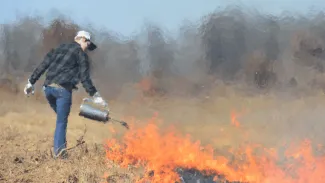The benefits of prescribed burning for wildlife have been well documented, especially when managing for white-tailed deer, wild turkey, and bobwhite quail. Even more, prescribed burning continues to be one of the most cost-effective wildlife management tools available to land managers. The question is, can prescribed burning help to control tick infestations too?
Quite a bit of research has investigated this question over the years and though the results are a bit mixed, the general answer is yes. Multiple variables play a role in the effectiveness of fire as a tool against ticks, but when all facets come together tick abundance can be lower within fire-managed communities. This is great news for landowners with tick-infested pastures, rangelands, grasslands, shrublands, woodlands, and forests.

Of course, ticks can be killed directly by the flames and heat during a prescribed burn but, often, it’s the indirect effects that disfavor the short- and long-term tick abundance within a fire-managed community. Simply, ticks are at a disadvantage when high temperatures and a low relative humidity reign for extended periods, and fires help remove the refuge they need to escape these harsh conditions.
In general, ticks are quick to climb trees or vegetation to wait for a passing host but, eventually, unsuccessful ticks must seek favorable conditions to rehydrate. In other words, ticks are sensitive to water loss through evaporation, and a moisture-rich microhabitat of leaf litter and accumulated biomass at ground level offers the shelter they need to survive and persist.
Thankfully, a well-timed and planned prescribed burn can alleviate this microhabitat in the short term. Then, through rotational burning over multiple years, prescribed burning can help lessen tick levels to more manageable levels across an entire property. On the flip side, one burn every 8 or 10 years will likely have little long-term effect on tick abundance.
It’s important to reiterate that not all prescribed burns are the same and different habitat types will require different burning strategies if reducing tick numbers is a goal. Habitat condition usually plays a role too. Remember, removing or altering the ground layer microhabitat is the key to reducing the suitability of the community for tick habitation. Patchy burns will remove some, but not all, ground litter, leaving plenty of places for ticks to hide, shelter, and persist. Timing the burn for the right time of year and under the right burning conditions will get the best results.

Burning Assistance
And this leads to some great news! Oklahomans are blessed that burning assistance is readily available across the state. Valuable information about implementing prescribed fire is available through the Oklahoma Prescribed Burn Association’s website at ok-pba.org. In addition, almost 60 percent of the counties within the state have an established burn association that landowners can join to get on-site burning assistance. Plus, burn associations and regional burn coordinators are available to help landowners develop burn plans tailored to meet landowner goals and adhere to state and local laws. And for those counties without a burn association, the website has a link to help get one started.
So, if ticks have "dug in" among the habitats on your property and numbers seem a bit out of hand, adding some rotational prescribed burning may help. Plus, it’s a great way to enhance habitats and grazing lands for wildlife and livestock alike.